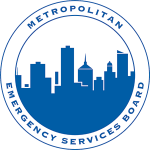9-1-1 in the Twin Cities Metropolitan Area
In the 1970’s the Metropolitan Council began planning for a regional 9-1-1 system for the metropolitan area, including the counties of Anoka, Carver, Dakota, Hennepin, Ramsey, Scott and Washington. As plans to implement the system became closer to reality, a new board was formed, the Metropolitan 9-1-1 Board, to oversee implementation, operation, and management of the Enhanced 9-1-1 (E9-1-1 system) being constructed in the region. The Metropolitan 9-1-1 Board was established under a joint powers agreement of the aforementioned seven counties and met for the first time in June 1979. Under the Board, the E9-1-1 system was installed in 1981 and made available for public use in December 1982. Though it has received updates, the E9-1-1 system is still in operation today.
E9-1-1 systems were built for wireline 9-1-1 calls. In E9-1-1, when a 9-1-1 call is placed from a wireline phone, automatic location information (ALI) is transmitted to the public safety answering point (PSAP) as the caller’s location; this works for wireline phones as these phones are static. The telephone company enters the customer’s service address into the 9-1-1 ALI database on the customer’s behalf upon signing up for service.
The Federal Communications Commission (FCC) introduced rules for 9-1-1 calls made from wireless phones to also provide location. Because someone calling 9-1-1 from a wireless phone could be anywhere (not just at the billing address), the caller’s approximate location is passed to the PSAP for these calls. In the early deployment of wireless 9-1-1 service, Phase 1 wireless calls provided PSAPs with the telephone number being used to call 9-1-1 and the location of the cellular tower site transmitting the call. Later, as location determination technology improved, Phase 2 wireless calls provided PSAPs the telephone number being used to call 9-1-1, but also provided better caller location. The Federal Communications Commission requires wireless carriers to provide caller location accurate to within 50 – 300 meters of the caller, depending on the technology the wireless carrier uses. Because a wireless 9-1-1 caller’s approximate location is sent to the PSAP, it is vital that wireless 9-1-1 callers know their actual location so emergency responders can be dispatched to the correct location.
In 2005, the Metropolitan 9-1-1 Board became the Metropolitan Emergency Services Board (MESB) when it undertook the duties for the metropolitan portion of the statewide Allied Radio Matrix for Emergency Response (ARMER) radio system from the former Metropolitan Radio Board. Today, the MESB continues to administer and manage both the metro portion of the ARMER system and the metro region 9-1-1 system on behalf of the original seven counties, plus Chisago, Isanti, and Sherburne Counties, which became MESB members in 2006, 2010, and 2019 respectively.
Today, the MESB works closely with the Minnesota Department of Public Safety, Division of Emergency Communication Networks (ECN) to not only manage the current E9-1-1 system, but to plan and implement Next Generation 9-1-1 (NG9-1-1). NG9-1-1 is Internet protocol based and will provide increased functionality for 9-1-1 callers and Minnesota’s public safety answering points, which answer 9-1-1 calls and dispatch public safety resources in response to those calls.
